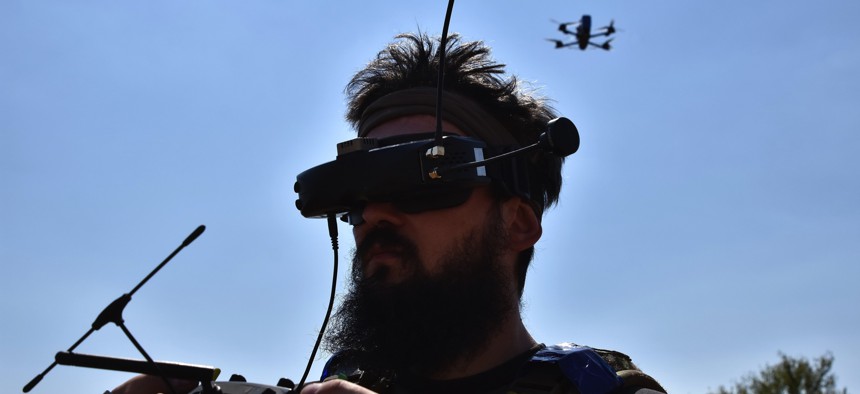
A drone operator of the 15th Brigade (Kara-Dag) of the National Guard of Ukraine seen with a FPV (first-person view) kamikaze drone on a wheat field after a military training exercise. Andriy Andriyenko/SOPA Images/LightRocket via Getty Image
Ukraine’s milestone shows drones prevent defeat, but don’t secure victory
Drone innovation is speeding up, but war has not followed. Is this the future?
Ukraine has reached a milestone, the country’s Ministry of Defense announced Monday: more than one million drones delivered to military units since January, with two million expected by the end of the year.
Yet this achievement illustrates a counterintuitive phenomenon: increasing the speed of innovation and deployment of new technologies may not produce battlefield gains.
“Those one-way attack drones are not going to gain air superiority, and they don’t have air superiority—and that’s really one of the key attributes of the conflict in Russia-Ukraine, is no one does,” Gen. Alexus Grynkewich, commander of U.S. European Command, and Supreme Allied Commander Europe, said last week at an NDIA event in Washington, D.C. A "core mission" of U.S. and NATO forces, Grynkewich said, is maintaining air superiority when even small militaries can rapidly erode U.S. advantage.
Ukraine had help reaching its goal. Among the million-plus drones are U.S.-made Switchblade and Ghost drones, as well as $2.5 billion donated by nongovernmental groups and citizens since 2024.
But Ukraine has also radically reformed contracting procedures and opened direct web exchanges, allowing frontline commanders to obtain drones directly from manufacturers. The Ukrainian government says commanders can now order and receive weapons in as little as five days.
This has helped convert a 20th-century military into one that can fight much larger and better-financed adversaries. The Pentagon, which has struggled to produce large numbers of cheap, highly autonomous drones, is taking note.
Emil Michael, U.S. defense undersecretary for research and development, speaking at the NDIA event, said the new U.S. approach “mimics what the Ukrainians have done. They push down the innovation to a very small unit level. They’ve competed them on which drones work better. Then they give more financing to the ones that work better. So that’s their model. Our model is going to be: bring it down to the unit level, reduce the barriers, provide broad training grounds.”
Several Defense Department initiatives to accelerate the development and proliferation of drones are reaching milestones of their own as development and production accelerate. Since January, the Defense Innovation Unit has picked contractors from a competitive pool and completed a prototype for its Artemis drones, said Col. Glenn McCartan, DIU's embed with U.S. European Command. That timeline may seem long compared with Ukraine’s drone development, but is much faster than traditional U.S. procurement.
More importantly, McCartan said, DIU has helped open communication lines between drone makers and commanders, allowing for small, fast purchases. This includes commanders in Europe who are working to stockpile drones and other weapons for NATO's Eastern Flank Deterrence Line.
In April, Ukraine’s former commander-in-chief, Gen. Valeriy Zaluzhny, observed that modern victory now depends on “the ability to outpace the enemy in technological development.” But this raises a larger question: outpace to where?
Ukraine’s million-drone force exists not just because of builder-to-soldier business relationships, but also because of broader trends in information-technology democratization. Digital tech has become exponentially cheaper, more powerful, and more available. It is the same trend that created the modern IT-led digital economy that has displaced last century’s enterprises focused physical assets.
But Ukraine’s “static front line,” as U.S. Army War College professor Frank Sobchak called it in August, also shows that while rapid technology development can erode an opponent’s advantage, it does not necessarily build advantage of its own. The result is a new type of conflict: more nimble operations and far faster invention and deployment of new weapons, but slower decisive wins.
Grynkewich said U.S. air dominance will have to come from a mix of next-generation platforms, fighters and bombers—manned and unmanned—alongside cheap drones.
But the democratization that allowed Ukraine to build a massive drone force in just months does not lend itself to the construction of highly complex fighters and bombers, or other systems apart from consumer electronics, Michael acknowledged.
“With a drone, you can go from start to prototype in 18 months. You can’t do that for an F-35, right? You can’t have a startup just say, ‘Here’s an airplane.’”
In other words, fighter jets remain necessary, but technology trends are rendering them obsolete more quickly, so the U.S. advantage in air dominance is dissolving more rapidly—and coming at higher cost.
For Michael, the key to building new U.S. dominance is continued investment in digital infrastructure away from the battlefield. For example, he said he is looking for ways to deploy artificial intelligence across the entire Defense Department.
Defense One asked Michael about a recent MIT analysis and comments from AI technology leaders suggesting a potential drop in funding to the sector.
“We had the same thing with the internet. We had the same feeling with mobile phones. I think we’re going through the same cycle with AI right now, where we’re not sure where it ends. My instinct says it ends the same way the internet and mobile phones did. AI becomes a critical part of what we do every day. The infrastructure around it is much more significant than you think it’ll be, and the advantages you can get from it are much greater than you could possibly imagine sitting right at the beginning.”

